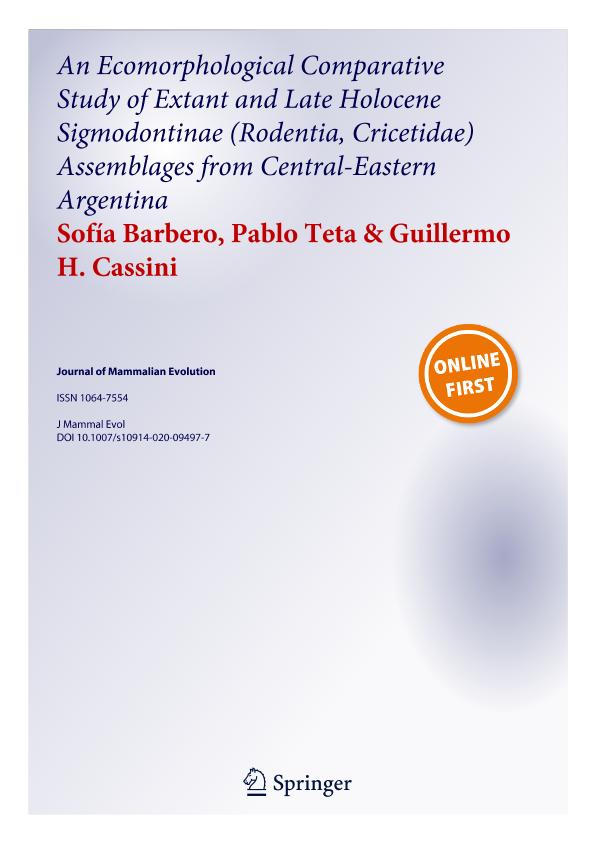Mostrar el registro sencillo del ítem
dc.contributor.author
Barbero, Sofía

dc.contributor.author
Teta, Pablo Vicente

dc.contributor.author
Cassini, Guillermo Hernán

dc.date.available
2021-05-31T18:25:37Z
dc.date.issued
2020-12
dc.identifier.citation
Barbero, Sofía; Teta, Pablo Vicente; Cassini, Guillermo Hernán; An ecomorphological comparative study of extant and Late Holocene Sigmodontinae (Rodentia, Cricetidae) assemblages from central-eastern Argentina; Springer; Journal of Mammalian Evolution; 27; 4; 12-2020; 697-711
dc.identifier.issn
1064-7554
dc.identifier.uri
http://hdl.handle.net/11336/132851
dc.description.abstract
The anthropic effect associated with worldwide European settlements over the last 500 years has caused dramatic environmental changes, modified regional patterns of biodiversity, and often led to local or complete extinctions. The sigmodontine rodents of Bahía Samborombón (Humid Pampas, central-eastern Argentina) constitute a good case study: a late Holocene archaeological site allowed us to compare a pre-European settlement assemblage (12 species) with the extant one (nine species). We used linear morphometrics (16 cranial and ten mandibular measurements) to assess interspecific morphological variations of the masticatory apparatus in relation to dietary habits for each assemblage. Even though sigmodontines have a tendency towards omnivory, groups based on dietary preference only overlapped partially. Size was one of the main variables involved in niche segregation, and shape characteristics such as rostrum elongation or mandible robustness were linked to different diets. We found that a combination of dietary preference and size was associated with extinctions. The main morphospace change between the two assemblages was related to the local extinction of the three greater insectivores and the smallest graminivore, located towards the center of the assemblage’s morphospace. An insectivore was incorporated, involving no significant changes in the general morphospace. Graminivores and larvivores were not affected. Our study sheds light on the causes of local extinctions of small mammals at the Humid Pampas, a phenomenon that had never been studied from an ecomorphological approach.
dc.format
application/pdf
dc.language.iso
eng
dc.publisher
Springer

dc.rights
info:eu-repo/semantics/openAccess
dc.rights.uri
https://creativecommons.org/licenses/by-nc-sa/2.5/ar/
dc.subject
ANTHROPIC EFFECT
dc.subject
CRICETID
dc.subject
ECOMORPHOLOGY
dc.subject
LOCAL EXTINCTION
dc.subject
PAMPA
dc.subject
RODENTS
dc.subject.classification
Otros Tópicos Biológicos

dc.subject.classification
Ciencias Biológicas

dc.subject.classification
CIENCIAS NATURALES Y EXACTAS

dc.title
An ecomorphological comparative study of extant and Late Holocene Sigmodontinae (Rodentia, Cricetidae) assemblages from central-eastern Argentina
dc.type
info:eu-repo/semantics/article
dc.type
info:ar-repo/semantics/artículo
dc.type
info:eu-repo/semantics/publishedVersion
dc.date.updated
2021-05-28T16:04:08Z
dc.journal.volume
27
dc.journal.number
4
dc.journal.pagination
697-711
dc.journal.pais
Alemania

dc.journal.ciudad
Berlin
dc.description.fil
Fil: Barbero, Sofía. Consejo Nacional de Investigaciones Científicas y Técnicas. Oficina de Coordinación Administrativa Parque Centenario. Museo Argentino de Ciencias Naturales "Bernardino Rivadavia"; Argentina
dc.description.fil
Fil: Teta, Pablo Vicente. Consejo Nacional de Investigaciones Científicas y Técnicas. Oficina de Coordinación Administrativa Parque Centenario. Museo Argentino de Ciencias Naturales "Bernardino Rivadavia"; Argentina
dc.description.fil
Fil: Cassini, Guillermo Hernán. Consejo Nacional de Investigaciones Científicas y Técnicas. Oficina de Coordinación Administrativa Parque Centenario. Museo Argentino de Ciencias Naturales "Bernardino Rivadavia"; Argentina. Universidad Nacional de Luján. Departamento de Ciencias Básicas; Argentina
dc.journal.title
Journal of Mammalian Evolution

dc.relation.alternativeid
info:eu-repo/semantics/altIdentifier/url/http://link.springer.com/10.1007/s10914-020-09497-7
dc.relation.alternativeid
info:eu-repo/semantics/altIdentifier/doi/http://dx.doi.org/10.1007/s10914-020-09497-7
Archivos asociados
